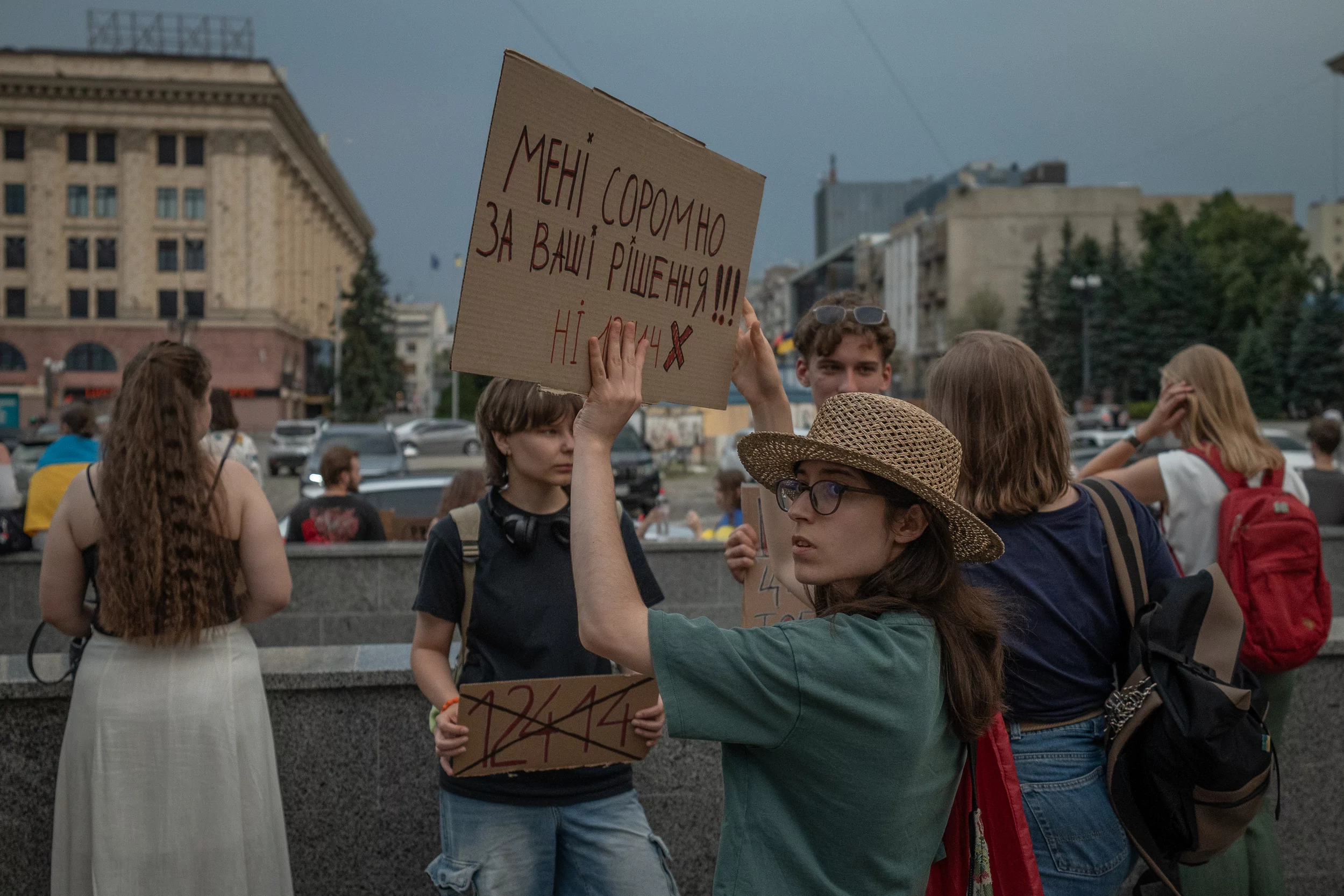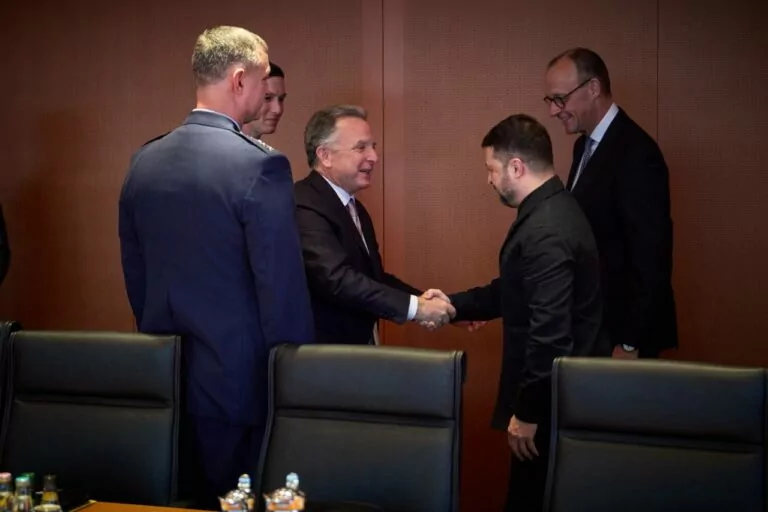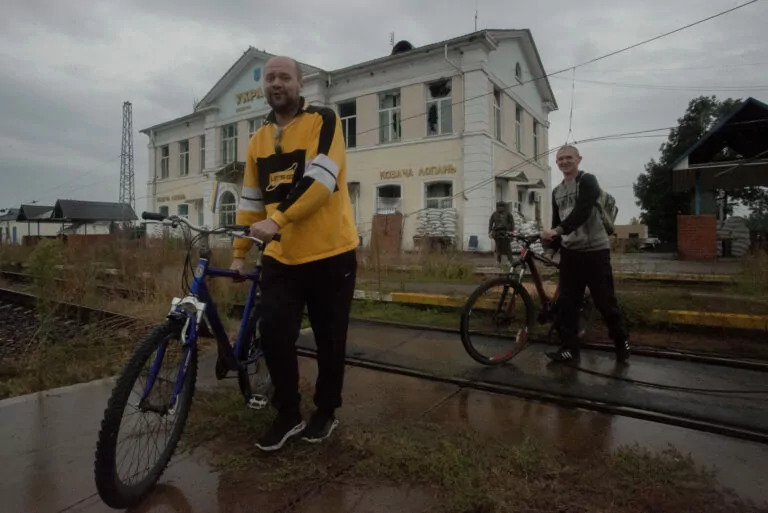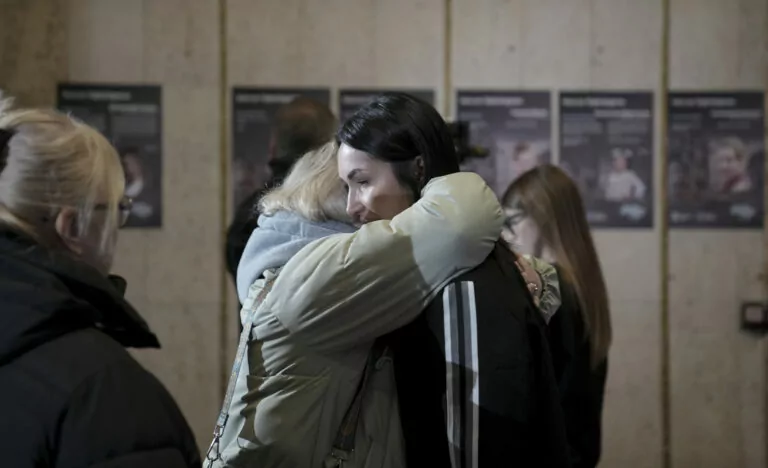After Ukraine’s Parliament adopted bill #12414 limiting the independence of anti-graft bodies, NABU and SAPO, people across Ukraine went out to protests. On the same day, Volodymyr Zelenskyy signed the bill, despite many asking to veto it. These events became a major topic of discussion for pro-Kremlin media and other online sources from June 22 to June 33.
Ukraine’s main intelligence agency (HUR) warned that Russia might use its resources and disinformation networks to “increase the level of protests, deepen polarization and chaotization of Ukrainian society and, as a consequence, make (the state — ed.) lose its resilience during an existential war.”
Manipulative messages went through pro-government media, anonymous Telegram channels, and Kremlin-linked propagandists, aimed at corrupting the meaning of democratic processes in Ukraine and promoting Russia’s geopolitical goals.
Gwara Media’s fact-checking department researched how exactly anti-corruption protests in Ukraine became a target for a Russian information attack and which disinformation narratives were promoted in the campaign.
Channels used to spread the disinfo
Traditionally, the Kremlin propaganda network reacts quickly to internal events in Ukraine that can be interpreted as signs of instability, societal dissent, or disappointment. Protests starting on July 22, 2025, in Ukraine became an occasion like that. A few hours following the first protests in Kyiv and Lviv, pro-Russian press, Telegram channels, and bot farms launched a wave of manipulative messages.
Main platforms to spread these messages were:
- Anonymous Telegram channels such as “Legitimate,” “Residents,” “ZeRada,” and so on. They were posting messages like “Protests are a consequence of Zelenskyy behaving like a dictator” or “Law #12414 is a step toward democracy. People have rebelled, and the army may pick their side.”
- English-language media and bloggers spread pro-Russian narratives. The Gateway Pundit, Redacted, InfoBrics, and The Grayzone’s articles said “Ukraine became an authoritarian state where dissidents are repressed,” linking to the comments of Marjorie Taylor Greene.
- X accounts in social media, Russian Market, AmericaPapaBear, and UkraineTruthDaily, along with pro-Kremlin YouTube and TikTok accounts published protest videos taken out of context with hashtags #ZelenskyDictator, #UkraineProtests, #WeWantPeace. These hashtags were then used to create an appearance of the “anti-war” movement in Ukraine — Russian troll farms often use this narrative to prop up the image of “war fatigue” in the country.
All of those resources began to construct a twisted information landscape, in which Ukrainians supposedly “rebelled against Zelenskyy’s dictatorship.” The real meaning of the protest — the protection of the anti-corruption system and its independence — was ignored or distorted.
False narratives about protests
Narrative #1. “Ukraine rebelled against Zelenskyy, not for reforms.”
Messages like these aimed to convince people that the protests were directed specifically against Zelenskyy, not the bill — and then the law — that he and the Parliament have supported. It was done to spread distrust to the authorities’ legitimacy and destroy their support.
In particular, pro-Russian Telegram channels called “Resident,” “Legitimacy,” “Truha LIve” used the phrases like “Zelenskyy’s fear,” “People have taken to the street against the dictator,” “New maidan,” and so on.
Narrative #2: “The West is keeping silent about protests in Ukraine.”
These were messages about European and American media supposedly “keeping silent” about the protests because covering them “isn’t beneficial.” Posts with messages like “BBC is silent,” “CNN won’t show that” spread on X. Authors also said that NATO “forbade” Western media to broadcast the protests in Ukraine.
As such, in Russian Market’s X post that gained up to 250,000 views, there’s a message that NATO issued a “ban” on the most prominent western media to show anti-corruption protests in Ukraine. That statement was debunked by NATO’s spokesperson in a comment to AAP FactCheck.
Apart from that, in the post, the Ukrainian protests are compared with the Tiananmen Square protests in China. Back then, student protests of 1989 grew into anti-government protests and then a massacre by the People’s Liberation Army.
Western media, particularly the BBC and CNN, mentioned in a post, weren’t actually silent about the protests. They informed people about the situation in Ukraine right up until July 31, when Ukraine’s parliament adopted and President Zelenskyy signed into law that restores independence of anti-corruption agencies.
Ukrainian media mostly didn’t adopt manipulative narratives which didn’t allow for the disinformation to spread into the mainstream.
Andrii Yanitskyi, journalist and the head of “ProMedia” NGO, said to Detector Media about the role of media covering the protests:
“It’s a challenging task, because it’s necessary to be a facilitator of democracy and realize that the country is at war, which is why hype and speculations can have negative consequences. I don’t agree that the media have to avoid certain topics or self-censor, no. But the way they convey information matters, so it’s necessary to be socially responsible. I think quality content producers (for instance, media that the IMI whitelisted) are experienced enough to hold this balance.”
Narrative #3. “Protesters demand peace with Russia.”
Posts about participants of the protests “taking to the streets” not against corruption, but to demand to “stop war” and make a peace deal were shared by pro-Russian channels to legalize the thesis, “Ukrainians are tired of war.” This message was propped by Marjorie Taylor Greene, who published the following post on July 23:
“Huge protests erupt in Kyiv against Ukrainian President Zelensky as he is a dictator and refuses to make a peace deal and end the war. Good for the Ukrainian people! Throw him out of office! And America must STOP funding and sending weapons!!!”
This message from Congresswoman echoes the pro-Russian statements. In the past, foreign media and analysts (Newsweek, Guardian, Washington Post) described her as “Russian state media’s sweetheart” because she is regularly quoted in Russian spaces online.
Green multiple times called (archive) for a stop of American aid to Ukraine. She also promoted the narrative that Ukraine provoked a Russian invasion, “making alliance with the West.” In 2024, Green proposed a series of amendments to the bill for aid to Ukraine, in which she demanded to not allow the money to be spent until “free and fair elections” will be held in Ukraine.
Narrative #4. “Ukraine is a dictatorship.”
During July 24-28, content tagged with #ZelenskyDictator was actively shared on social media. Accounts on X and TikTok published the same messages in English, targeting audiences in the UK and the US.
These accounts spread information on Zelenskyy, who was supposedly “cracking down on dissent, opposition, and citizens’ protests.” Equating Ukraine with an authoritarian regime, they aimed to distort the trust of Ukraine’s allies.
Gwara Media’s fact-checkers, for instance, debunked a fake that an activist who brought a dog to the protest has been charged with animal cruelty. The “news” said that the case was supposedly opened because of an activist’s sign that called Zelenskyy a dog.
The Institute for the Study of War (ISW) said that Kremlin officials, propagandists, and mouthpieces have weaponized these protests to advance existing Russian narratives designed to portray the Ukrainian government as corrupt and illegitimate to discourage Western support for Ukraine.
“The ongoing Ukrainian protests are notably not anti-war demonstrations, but Russian commentators are trying to paint them as protests against Zelensky and Ukraine’s war effort to accomplish informational effects that will generate benefits for Russian forces on the battlefield,” the ISW said.
The messages spread by pro-Russian sources about the “complete failure of anti-corruption politics” and “dictatorial leadership” aimed to strengthen polarization and weaken the trust in reforms needed for Ukraine’s accession to the EU. If anything, the EU’s representatives echoed the protesters, saying that reforms and independence of anti-corruption institutions are necessary.
So, the Kremlin tried to masquerade internal societal processes in Ukraine with a twisted picture of chaos to dissolve international support for Ukraine. Head of the Foreign Intelligence Service of Ukraine, Oleh Ivashchenko, says that Russia used and will use any occasion to destroy unity and discredit Ukraine, especially on the international stage.
“I communicate almost daily with the heads of partner special services on joint counteracting Russia’s aggression. Colleagues point to the importance of maintaining the phenomenal level of consolidation of Ukrainian society, which we have shown during these years of war.”
Author: Olga Yakovleva
Cover credit: Protest against bill #12414 in Kharkiv on July 30 with a sign “I am ashamed of your decisions” / Liubov Yemets, Gwara Media
 |
|---|
The project is co-financed by the governments of Czechia, Hungary, Poland and Slovakia through Visegrad Grants from the International Visegrad Fund. The mission of the fund is to advance ideas for sustainable regional cooperation in Central Europe.
The project is supported by the Ministry of Foreign Affairs of the Republic of Korea.



